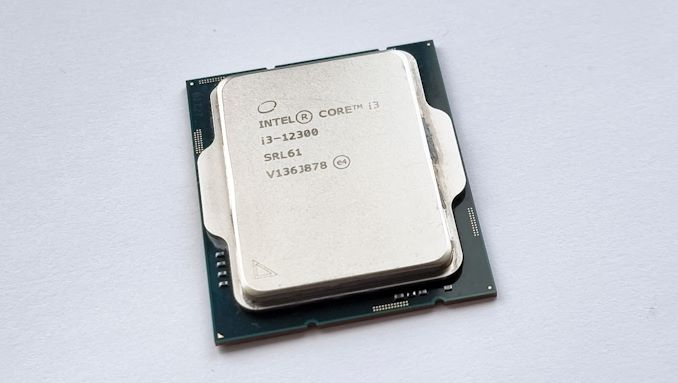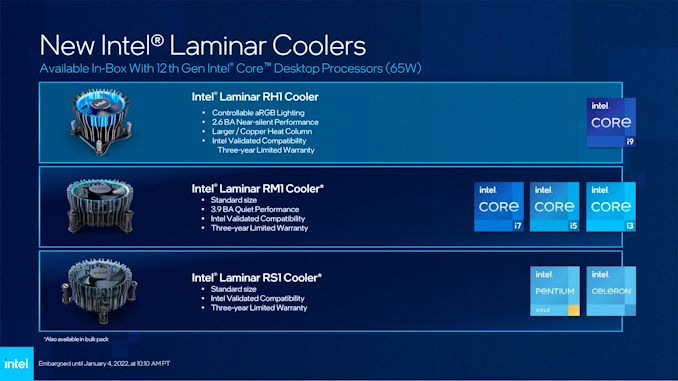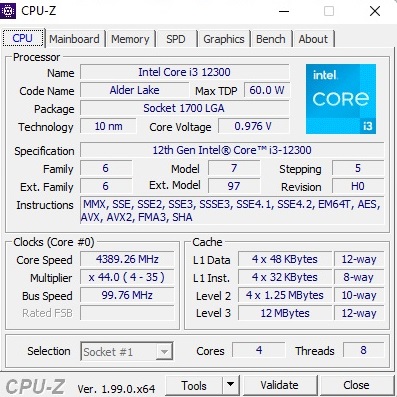The Intel Core i3-12300 Review: Quad-Core Alder Lake Shines
by Gavin Bonshor on March 3, 2022 8:30 AM EST
Just over a month ago Intel pulled the trigger on the rest of its 12th generation "Alder Lake" Core desktop processors, adding no fewer than 22 new chips. This significantly fleshed out the Alder Lake family, adding in the mid-range and low-end chips that weren't part of Intel's original, high-end focused launch. Combined with the launch of the rest of the 600 series chipsets, this finally opened the door to building cheaper and lower-powered Alder Lake systems.
Diving right in, today we're taking a look at Intel's Core i3-12300 processor, the most powerful of the new I3s. Like the entire Alder Lake i3 series, the i3-12300 features four P-cores, and is aimed to compete in the entry-level and budget desktop market. With prices being driven higher on many components and AMD's high-value offerings dominating the lower end of the market, it's time to see if Intel can compete in the budget desktop market and offer value in a segment that currently needs it.
Below is a list of our detailed Intel Alder Lake and Z690 coverage:
- The Intel 12th Gen Core i9-12900K Review: Hybrid Performance Brings Hybrid Complexity
- Intel Architecture Day 2021: Alder Lake, Golden Cove, and Gracemont Detailed
- Intel Announces 12th Gen Core Alder Lake: 22 New Desktop-S CPUs, 8 New Laptop-H CPUs
- The Intel Z690 Motherboard Overview (DDR5): Over 50+ New Models
- The Intel Z690 Motherboard Overview (DDR4): Over 30+ New Models
As a quick recap, we've covered Alder Lake's dual architectural hybrid design in our Core i9-12900K review, including the differences between the P (performance) and E (efficiency cores). The P-cores are based on Intel's high-performance Golden Cove architecture, providing traditional high single-threaded performance. Meanwhile the Gracemont-based E-cores, though lower performing on their own, are significantly smaller and draw much less power, allowing Intel to pack them in to benefit multi-threaded workloads.
Intel Core i3-12300 Processor: Less is Moore
Aside from the two top Core i5 models (i5-12600K and i5-12600KF), all of chips below that level, including the Core i3, Pentium, and Celeron series, only feature Intel's Golden Cove P-cores. Intel's 12th generation Core i3 processors feature four such P-cores, with 12 MB of L3 cache, and all but one (i3-12100F) uses Intel's Xe-LP architecture-based UHD 730 integrated graphics.
Intel's 12th generation Alder Lake desktop processors have been split into the following naming schemes and Performance (P) core and Efficiency (E) core configurations:
- Core i9: 8 Performance Cores + 8 Efficiency Cores
- Core i7: 8 Performance Cores + 4 Efficiency Cores
- Core i5: 6 Performance Cores + 4 Efficiency Cores/6P Only
- Core i3: 4 Performance Cores Only
- Pentium: 2 Performance Cores Only
- Celeron: 2 Performance Cores Only
The Intel Core i3-12300 is the top i3 SKU in the lineup and has a base frequency of 3.5 GHz (60 W), with a turbo frequency of 4.4 GHz (89 W). Other variants vary in core frequency, with different models focusing on lower-powered systems, including the Core i3-12300T, which has a base TDP of 35 W at 2.3 GHz, with turbo clock speeds reaching 4.2 GHz with a 69 W TDP.
| Intel Core i3 Series (12th Gen Alder Lake) | ||||||||
| Processor | Cores P+E |
P-Core Base (MHz) |
P-Core Turbo (MHz) |
L3 (MB) |
IGP | Base (W) |
Turbo (W) |
Price ($1ku) |
| i3-12300 | 4+0 | 3500 | 4400 | 12 | 730 | 60 | 89 | $143 |
| i3-12300T | 4+0 | 2300 | 4200 | 12 | 730 | 35 | 69 | $143 |
| i3-12100 | 4+0 | 3300 | 4300 | 12 | 730 | 60 | 89 | $122 |
| i3-12100F | 4+0 | 3300 | 4300 | 12 | - | 58 | 89 | $97 |
| i3-12100T | 4+0 | 2200 | 4100 | 12 | 730 | 35 | 89 | $122 |
At the time of writing, there are five Core i3 processors announced so far. While the interpretation of TDP can be taken in different ways depending on the company and how it is measured, Intel has gone one step further by offering both TDP at the base frequency and turbo frequencies. Three of these are standard non-K SKUs, while two of these feature the T naming moniker, which signifies that they have a base TDP of just 35W, perfect for lower-powered systems.
Interestingly, only one of the Core i3 processors, the i3-12300T has a turbo TDP of 69 W, while the rest have a rating of 89 W with turbo enabled, including the i3-12100T. The odd one out is the Core i3-12100F, which has a slightly lower base TDP of 58 W, likely as this is the only Core i3 not to include Intel's UHD 730 integrated graphics. It is also the cheapest, with a per 1k unit price of $97.

For this generation Intel has also refreshed its stock CPU coolers, which is the first time it has done this in quite a long time. Although none of the K-series processors include one, aftermarket cooling is necessary to utilize its Thermal Velocity Boost (TVB) and Intel's new 'infinite turbo.' This means that the processor under heavier workloads will try and use turbo as much as possible, which can mean better cooling is needed on the parts with higher P and E-core counts. In the case of the Core i3 series, the maximum TDP figure Intel provides is 89 W, so any conventional CPU cooler should be able to sustain turbo clock speeds for a more extended period of time.
The Core i3 series is shipped and bundled with Intel's new Laminar RM1 CPU cooler, which is similar in size to previous iterations of its stock cooler. Unlike the RH1, the RM1 doesn't feature RGB LED lighting and uses a traditional push-pin arrangement to mount into the socket. Intel hasn't stated which material it uses, e.g., copper or aluminum, or a combination of the two, but regardless of the materials used, for sub 100 W workloads these coolers should be more than ample for the Core i3 series.
The Budget CPU Market: Core i3-12300 versus AMD
Users have lots of choices available in terms of LGA1700 motherboards, including Z690, B660, H670, and H610, as well as support for either DDR5 and DDR4 memory. Users can pair up the Core i3-12300 with the more expensive DDR5 and Z690 for the absolute greatest performance, but the target audience for the Core i3 is users on a budget. This means that users are more likely from a cost perspective to build a system with one of the more affordable B660, H670, and H610 chipsets and pair that with DDR4 memory.
In terms of the competition from AMD, the green team is effectively absent from the sub-$200 quad core market for the moment. AMD does have a more-or-less direct competitor to the Alder Lake i3s in the Ryzen 3 5300G. However, as that chip is OEM-only (and terribly expensive on the gray market), as far as the retail market and individual system builders are concerned, it's all but unavailable. Which means that, at least amidst the ongoing chip crunch, Intel has the run of the market below $200. That said, we are including it in our graphs for completion's sake, and to outline where AMD would be if they could provide their quad core chips in greater volumes.
The next best competitor for the i3-12300 then is arguably the Ryzen 5 5600X, which is an ambitious task and admittedly somewhat lopsided task. The AMD Ryzen 5 5600X is based on its Zen 3 architecture and has six cores versus the four of the i3-12300, while the 5600X also benefits from four more threads (12). Intel's Alder Lake architecture also benefits from PCIe 5.0, but right now there aren't any (consumer) devices that can utilize the extra bandwidth available. The AMD Ryzen 5000 series uses PCIe 4.0 on X570, with PCIe 4.0/3.0 on B550 and below.

Intel Core i3-12300 CPU-Z screenshot, 4C/8T
Aside from architectural, core count, and thread count differences between the Intel Core i3-12300 and the AMD Ryzen 5 5600X, the next biggest difference is the price. The Ryzen 7 5600X has an MSRP of $299, although it can be found at Amazon at the time of writing for a recently trimmed price of $229. The Intel Core i3-12300 is much cheaper in contrast, with a per 1k unit pricing of $143. With the first shipments just now hitting the market, we expect the retail MSRP to be around the $160-170 mark.
Other processors from AMD that could be considered competitors are the 5000 series Cezanne APUs. This includes the Ryzen 5 5600G, which is currently $219 at Amazon. Despite being more focused on entry-level gaming with integrated Vega 7 graphics, it consists of six cores with a base frequency at 3.9 GHz and a turbo frequency of 4.4 GHz; the 5600G also benefits from twelve threads.
Finally, boxing things in from the other direction, Intel also has the Core i5-12600K processor with six P-cores and four E-cores, with a price tag of $280 at Newegg. We will be reviewing the Core i5 a bit later this month, and it is currently on our testbed undergoing our CPU test suite at the time of writing.
Test Bed and Setup
Although there were some initial problems with the Intel Thread Director when using Windows 10 at the launch of Alder Lake, the P-core only Core i3 stack doesn't need to worry about this. For our testing, we are running the Core i3-12300 with DDR5 memory at JEDEC specifications for Alder Lake (DDR5-4800 CL40). We are also using Windows 11 from now on for our CPU reviews.
For our test bed, we are using the following:
| Alder Lake Test System (DDR5) | |
| CPU | Core i3-12300 ($143) 4+0 Cores, 8 Threads 60W Base, 89W Turbo |
| Motherboard | MSI Z690 Carbon WI-FI |
| Memory | SK Hynix 2x32 GB DDR5-4800 CL40 |
| Cooling | MSI Coreliquid 360mm AIO |
| Storage | Crucial MX300 1TB |
| Power Supply | Corsair HX850 |
| GPUs | NVIDIA RTX 2080 Ti, Driver 496.49 |
| Operating Systems | Windows 11 Up to Date |
All other chips for comparison were run as tests listed in our benchmark database, Bench, on Windows 10.










140 Comments
View All Comments
skydiverian - Saturday, March 5, 2022 - link
It's been 2 months since non-K Alder Lake CPUs launched (including all quad core SKUs) and they are definitely available in the UK from reputable independent retailers that specialise in computer equipment. The 12100 is available & in stock for £135 - around £30 more than the 10100 and £5 less than the 10300. Not great prices but from experience fairly typical for the market, at least in the UK.The US isn't great though the usual suspects do have some options. Considering that everyone seems to have the 12xxxK SKUs in stock it will likely be easy to get whatever you want in a month or 2.
bwj - Thursday, March 3, 2022 - link
The fact that your i3 beats your i5 in Speedometer 2 implies a problem with the platform. Windows should be keeping a user-interactive process on the P cores all the time, but it seems from these results that Chrome's threads are wandering between P and E cores. There's really no other explanation for why the i5-12600K with 11% higher clocks gets a lower score.Personally I find the E cores more of a hazard than a benefit, and I have them disabled.
brantron - Thursday, March 3, 2022 - link
The scores are all too low. Prior reviews used Chrome 92, which is missing a significant V8 update for Windows.Mobile CPUs also exhibit this behavior, due to more hardware managed power states. It is a royal PITA to find the secret handshake that maintains their litany of peak clocks per CPU core, ring bus, memory controller, RAM, etc.
My Tiger Lake i5 goes from 160 to 200 in Speedometer by adding "processor energy performance preference policy" to the Windows power advanced power settings menu. Reducing it to 0% raises the minimum clock speed to about 3 GHz.
Alder Lake CPUs with E cores introduce another variable with the hardware thread scheduler. There is also a larger ring bus on the i5 12600K, which increases latency.
bwj - Thursday, March 3, 2022 - link
Yes the scores are extremely low. With current Chrome/Linux on an i7-12700K with the E-cores disabled I get 305.Considering that the browser is a compiler for Javascript it doesn't make a lot of sense to freeze its version. It would be nice if we could get a rolling picture, based on a few key reference systems, of what a buyer *today* would experience with *today's* software.
Makaveli - Thursday, March 3, 2022 - link
Those Speedometer scores have always been off. Take look at the thread in the forum with user posted scores.https://forums.anandtech.com/threads/how-fast-is-y...
kpb321 - Thursday, March 3, 2022 - link
Anyone else find the DDR4 vs DDR5 graphs annoying? I realize they are sorted by performance but with only 2 entries in each one I think it would make a lot more sense to just have a consistent order.CiccioB - Friday, March 4, 2022 - link
That would just introduce the problem that you must check if a lower bar is better than a longer one, or viceversa.Ordering it by performance allows to easily see which is faster and by what amount.
Mike Bruzzone - Thursday, March 3, 2022 - link
Beyond industrial embedded for control plane / processing [including coprocessing acceleration point of sale for example], I'm not sure why quads remain a subject of interest there are sooo many recent back generation options why even produce them today for mass market? Ryzen quads failing out of sort are relied in 1x8ccx+1x4ccx for dodadeca so they're still utilized but a standalone 4C/8t [?] there are so many good used options and hexa used [Coffee Lake] is gaining volume in the secondary market on system upgrade on hexa reclaim.All Alder i3 12300 available in the WW channel today equals 0.00047% of full line available. The top three AL SKUs are 12900K at 40.8%, 700K at 46.7% now at 87.6% of full line and number 3 SKU volume wise is 12400 at 2.5% and at number 4 is 12600K/Kf at 2.4% combined.
On finished component yield and silicon performance all Alder Lake are essentially 900K/700K that is similar to Coffee Refresh octa before disablement most 9th gen started out as 9900_.
On the AMD side you can purchase a used 2600 hexa for less than $100 and on WW channel availability that is for both used and new there are x126 more R5 2600 than i3 12300. Pursuant
AMD quads 5300G has currently x37 more channel available and R3 3300X x25.
Mike Bruzzone, Camp Marketing
Wereweeb - Thursday, March 3, 2022 - link
1) Speak english please2) An Alder Lake quad-core is equal or better than a Ryzen 5 2600. All benchmarks also show substantial improvements in 1% lows. What matters most is overall performance, not simply the number of cores.
3) The vast majority of people are just fine running a modern quad-core.
Wereweeb - Thursday, March 3, 2022 - link
And yes, by "vast majority of people" I mean people, not "hurr durr 360hz monitor" g*mers.